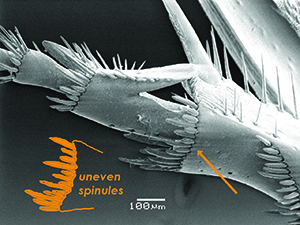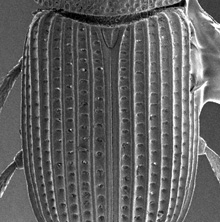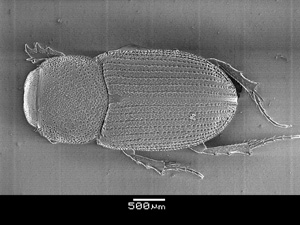1. |
Scutellum large, triangularly elongate, 1/5 to 1/3 as long as elytron (Fig. 1) | . |
| 1'. . |
Scutellum small, triangular to pentagonal, l/6 or less length of elytron (Fig. 2) | |
 |
 |
Figure 1. Otophorus haemorrhoidalis. |
Figure 2. Oscarinus odocoilis. |
2(1). |
Metatibial apex fringed with distinctly unequal spinules, mixed short and long (Fig. 3). Elytral intervals often dulled | . |
| 2'. . |
Metatibial apex fringed with short spinules of equal length (Fig. 4). Elytral intervals shiny | |
 |
 |
Figure 3.Diapterna hamata. |
Figure 4. Teuchestes fossor. |
3(2). |
Frontal suture lacking tubercles. Head and pronotum with punctures widely separated and unevenly distributed (Fig. 5). Elytron shiny or dull. Elytral humerus with fine or widely spaced moderate punctures | . |
| 3'. . . . . |
Frontal suture with median tubercle, often weak. Head and pronotum evenly covered with punctures separated by 1‑2 diameters (Fig. 6). Elytron alutaceous. Elytral humerus with coarse, narrowly separated punctures | |
 |
 |
Figure 5. Diapterna hyperborea. |
Figure 6. Colobopterus erraticus. |
4(3). |
Superior metatibial spur shorter than basal metatarsal segment. Male with protibial spur and basal metatarsal segment unmodified. South America | |
| 4'. . . . |
Superior metatibial spur longer than basal tarsal segment. Male with protibial spur and basal metatarsal segment greatly modified (Fig. 7-8). North America | |
 |
 |
Figure 7. Diapterna pinguella. |
Figure 8. Diapterna pinguella. |
5(2). |
Body large, longer than 10 mm. Scutellum weakly punctured near base, surface nearly impunctate (Fig. 9) | |
| 5'. . |
Body less than 8 mm long. Scutellum coarsely punctured on surface (Fig. 10) | |
 |
 |
Figure 9. Teuchestes fossor. |
Figure 10. Otophorus haemorrhoidalis. |
6(5). |
Pronotum with mixed fine and coarse punctures evenly distributed, separated by 2‑3 diameters (Fig. 11). Elytron with red apex. North America and Mexico | |
| 6'. . . . . |
Pronotum with fine and very coarse punctures, coarse punctures unevenly distributed, widely scattered, separated by 3‑8 diameters (Fig. 12). Elytron unicolored, lacking red apex. Northeastern North America | |
 |
 |
Figure 11. Otophorus haemorrhoidalis. |
Figure 12. Eupleurus subterraneus. |
7(1). |
All elytral intervals distinctly carinate on disc OR elytra with distinct humeral tooth, often both (Fig. 13) | . |
 Figure 13. Dialytes ulkei. |
||
| 7'. . . |
Elytral intervals variously modified, never carinate (except Xenoheptaulacus which is carinate on alternate intervals). Elytral humerus lacking tooth | |
8(7). |
Dorsal surface of protibia distinctly, densely punctured (Fig. 14) | . |
 Figure 14. Gonaphodiellus hoffmani, protibia. |
||
| 8'. |
Dorsal surface of protibia impunctate | |
9(8). |
Elytral intervals and striae finely carinate. Brazil (?) . |
|
| 9'. . |
Elytral intervals and striae not finely carinate. Mexico to South America | |
10(9). |
Elytral surface distinctly setose. Brazil (?) . |
|
| 10'. |
Elytral surface glabrous. Mexico to South America | |
11(10). |
Head and pronotal disc glossy, impunctate (Fig. 15). Pronotum constricted laterally. Mexico . |
|
| 11'. . . |
Head and pronotal disc distinctly punctured, often dull (Fig. 16). Pronotum emarginate at base, not constricted laterally. Mexico to South America | |
 |
 |
Figure 15. Imelda constricticollis. |
Figure 16. Gonaphodiellus hoffmani. |
12(8). |
Protibia with apical tooth close to tarsal insertion, projecting forward with tarsus (Fig. 17) | . |
| 12'. . |
Protibia with apical tooth removed from tarsal insertion and projecting away from tarsus (Fig. 18) | |
 |
 |
Figure 17. Dialytes ulkei. |
Figure 18. Calamosternus granarius, male |
13(12). |
Protibia slender, spur lacking (Fig. 19). Elytra distinctly bicolored. Chile | |
| 13'. . |
Protibia broad, spur distinct (Fig. 20). Elytra unicolor, dark. Eastern North America | |
 |
 |
Figure 19. Acanthaphodius bruchi, female. |
Figure 20. Dialytes striatulus. |
14(12). |
Elytron carinate (Fig. 21-22) | |
| 14'. . |
Elytron not carinate, intervals flat, convex or possibly tectiform, narrowly raised in middle (Fig. 23) | |
 |
 |
Figure 21. Oxyomus sylvestris. |
Figure 22. Strigodius robinsoni. |
 |
|
Figure 23.Dialytodius decipiens. |
|
15(14). |
Elytral striae with punctures as wide as carinate intervals (Fig. 24). Clypeal margin rounded. North America and Mexico | |
| 15'. . . . . . |
Elytral striae with punctures much narrower than interval (Fig. 25); intervals with row of punctures on each side of middle carina same size as strial punctures, giving each interval a tri‑carinate appearance obscuring striae. Clypeal margin distinctly dentate. Eastern North America | |
 |
 |
Figure 24. Oxyomus sylvestris. |
Figure 25. Strigodius robinsoni. |
16(14). |
Elytral intervals strongly and irregularly punctured, with scattered setae, dull appearing (Fig. 26). Pronotal base usually lacking marginal groove. Southwestern US and Mexico | . |
| 16'. . . . |
Elytral intervals weakly punctured or punctures in two regular rows, rarely with setae, most with glossy intervals (Fig. 27). Pronotal base rarely lacking marginal groove. Widespread | |
 |
 |
Figure 26. Neotrichonotulus inurbanus. |
Figure 27. Dialytellus dialytoides. |
17(16). |
Elytra short, laterally curved, not parallel-sided. Metatarsus distinctly pubescent; apical segments about as wide as long. Mexico | |
| 17'. . . . |
Elytra normal length, parallel-sided laterally. Metatarsus not pubescent, with few scattered setae; apical segments distinctly longer than wide. Mexico, southern Arizona | |
18(17). |
Anterior angles of pronotum not explanate (Fig. 28). Mexico, southern Arizona . |
|
| 18'. . |
Anterior angles of pronotum narrowly explanate (Fig. 29). Mexico | |
 |
 |
Figure 28. Neotrichonotulus inurbanus. |
Figure 29. Trichonotuloides glyptus. |
19(16). |
Pronotum with base narrower than apex and lacking distinct posterior angles (Fig. 30), or base distinctly sinuate (Fig. 31). Body of most longer than 7 mm, some western members 5 mm. North America | |
| 19'. . . . |
Pronotum with distinct posterior angles, lateral base not narrower than apex, base lobed or straight but not sinuate (Fig. 32). Body length usually less than 5 mm, except rare individuals | |
 |
 |
Figure 21. Oxyomus sylvestris. |
Figure 22. Strigodius robinsoni. |
 |
|
Figure 23.Dialytodius decipiens. |
|
20(19). |
Elytra distinctly mottled black and yellowish. Body wedge-shaped in lateral view (Fig. 33), head and pronotum somewhat flattened, elytra with greatest height near apical third. Mexico | |
| 20'. . . |
Elytra not distinctly mottled, some bicolored. Body not flattened (Fig. 34), approximately same height as elytra | |
 |
 |
Figure 21. Pseudogonaphodiellus zdzslawae, male. |
Figure 22. Dialytellus dialytoides. |